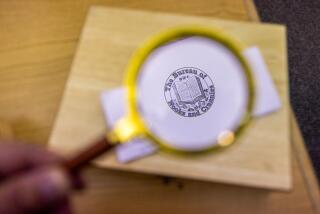A Pass to the Reading Room at British Library
My pass to the historic Reading Room of the British Library in the heart of the British Museum has just expired, leaving me feeling bereft.
It brought me as much pleasure during my days in London as an evening with Tom Stoppardâs âHapgoodâ or another favorite play, âLettice and Lovage,â starring the brilliant Maggie Smith.
Even the act of applying for a readerâs pass had moments of drama: What subject interested me? an outer librarian asked. Umm, the history of travel, I replied. What books would I need for my research? Umm, could I check the reference lists?
I normally avoid saying âUmm,â but it was first thing in the morning, a time when I normally avoid any questions.
What really interested me was seeing the famed round room with its soaring, sky-blue dome whose 140-foot diameter is greater than that of St. Paulâs in London or St. Peterâs in Rome. It opened to readers in 1857 on the site of a gloomy museum courtyard.
More Than Five Minutes
Visitors are allowed a five-minute view of the room every hour on the hour from 11 a.m. to 4 p.m., but I wanted more. I wanted to sit at a leather-topped desk and flick on a lamp and stare at the tiers of shelves that stretch for 25 miles.
I wanted to check out a book--any book--and peruse it in the silence of an airy hall whose vast collections have drawn scholars ranging from Mahatma Gandhi to Karl Marx, from Charles Dickens to George Bernard Shaw. I wanted a pass of my own.
And so I jotted down three titles listed under Voyages and Travels in the catalogue. I presented my passport and a letter from the British Tourist Authority saying that I was indeed a journalist.
The outer librarian nodded, then said: âNow look this way for a photograph.â Two snaps later and I was given a plastic pass with a serious, even studious, scowl on it.
Settling In at C-13
I entered the Reading Room with the solemnity of one who had taken religious vows, and walked in a circle to my right until I found an empty desk: C-13.
I settled in and studied the blotter and the sliding shelves above. I watched the light change from pale gold to silver as clouds flitted past the tall arched windows in the dome, which is more than 100 feet high.
The first words I read in that hallowed hall were from the pamphlet on regulations: You must not moisten your fingers to turn pages of any book belonging to the British Library; you must not put the paper upon which you are writing on any book, open or closed.
âReaders must not lean on books, or handle them roughly; they must not put them on the floor; they must not bend them back, lay them face downwards when open, or do anything else that might damage the binding; they must take care not to drop them; they must not fold any page, or straighten out creased or dog-eared pages as this may damage the book further.â
It did not conclude with âas long as you both shall live,â but that was the intimation.
North to Rare Volumes
To reserve a seat--and there are 400 of them--you leave something on the desk, âthough not money or items of value.â I left a jacket and took my book requests to the applications window at the center of the room.
While waiting for the books to be delivered to C-13 I wandered among the rare volumes of the adjacent North Library, where lustrous leather bindings covered classics from two inches in height to two feet. Their depth could not be measured.
In less than an hour I returned, and stacked on my desk were âThe History of Tourismâ by Sigaux, âGolden Hordesâ by Turner and Ash, and a volume in Swedish whose thrust may have been war or insects or lichens. I did not understand the language, and the photos were fuzzy.
Numerate Solution
Instead of concentrating on my self-assigned subject I tried to solve the mystery of the Swedish volume: How did it get to desk C-13?
Finally, I realized that I had requested a book whose shelf-mark number ended in 750. But I had not crossed my seven in the continental fashion, and so I had been delivered the Swedish book, which had the same number but ended in 150.
I did not complain. I was too happy to be on the inside looking up at this cast-iron gem of Victorian architecture.
I read for a while about golden hordes of tourists making their way from England to the rest of Europe. I glanced down the spokes of desks and tried to guess what was going on in the bowed heads of other readers. Who might be writing âDas Kapital IIâ? Who might be penning âPygmalionâ?
As I relinquished my desk I swore Iâd return. And next time Iâll stick to my subject.
More to Read
Sign up for The Wild
Weâll help you find the best places to hike, bike and run, as well as the perfect silent spots for meditation and yoga.
You may occasionally receive promotional content from the Los Angeles Times.






